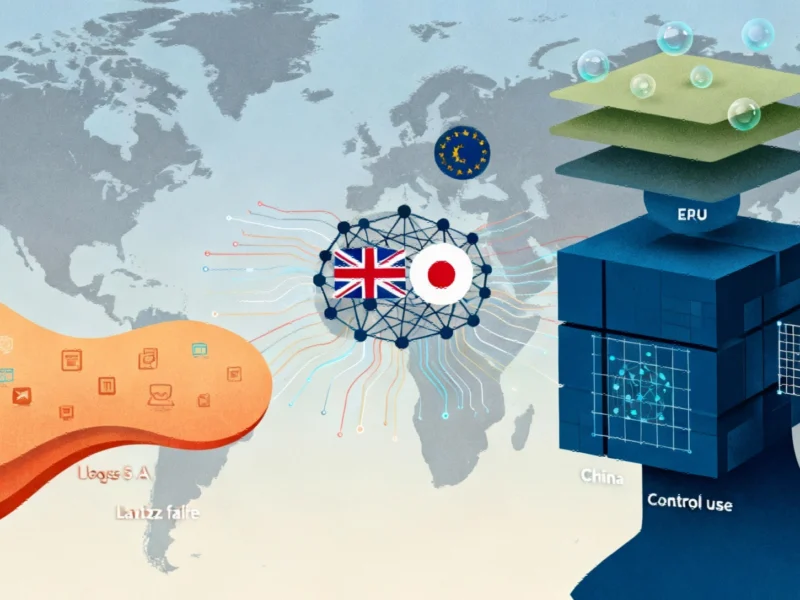A New Axis for Ethical AI Innovation
As nations scramble to position themselves in the global artificial intelligence race, two technologically advanced economies are emerging as potential leaders of a responsible AI alliance. The United Kingdom and Japan, through their strengthening partnership on balanced AI governance, are demonstrating that technological progress need not come at the expense of ethical considerations or human rights. This collaboration comes at a critical juncture when other global powers are pursuing dramatically different approaches to AI regulation and development.
The international landscape reveals stark contrasts in AI strategy. The United States continues its deregulatory approach to technology and energy priorities, while China maintains tight state control over digital technologies. Meanwhile, the European Union’s comprehensive AI Act represents another extreme, with companies like Siemens and SAP criticizing what they describe as overly restrictive legislation that could hamper innovation.
The UK’s Flexible Regulatory Framework
Britain has adopted a nuanced approach to AI governance that emphasizes guidance over rigid legislation. Rather than creating sweeping new laws, the UK government has built upon existing frameworks like GDPR while developing sector-specific guidance through its Department for Science, Innovation, and Technology. This approach allows regulators to interpret five pro-innovation principles within their specific contexts, addressing issues of safety, fairness, transparency and accountability without stifling creativity.
The UK’s pioneering AI sandbox program, launched in 2023, represents a particularly innovative aspect of this strategy. These controlled environments enable companies to test new technologies under enhanced regulatory supervision without facing immediate penalties. The sandboxes serve as trust-building tools between businesses and regulators while providing valuable insights about where guardrails are truly needed. However, the UK faces significant challenges in competing with massive international initiatives, as its AI Growth Opportunities Plan still suffers from questions about funding and policy cohesion.
Japan’s Society 5.0 Vision
Across the globe, Japan has articulated a compelling alternative vision through its “Society 5.0” initiative, which the Japanese Cabinet Office defines as “a human-centered society in which economic development and the resolution of social issues are compatible with each other.” This philosophy rejects the notion that growth and social responsibility must conflict, instead positioning technological progress as serving both goals simultaneously.
Japan’s commitment is backed by substantial investment, with Prime Minister Shigeru Ishiba announcing a US$65 billion investment plan in November 2024 focused on semiconductors and AI. Private sector involvement is equally robust, exemplified by Softbank’s partnership with OpenAI to build a US$677 million data center in Osaka. This stands in contrast to approaches seen elsewhere, such as Apple’s strategic navigation between US and Chinese interests, which highlights the complex geopolitical considerations in technology development.
Global Context and Challenges
The UK-Japan partnership emerges against a backdrop of increasing digital fragmentation and regulatory divergence. Recent developments highlight the difficulties in achieving international consensus, with Meta’s refusal to sign the EU’s AI Code of Practice demonstrating how perceived over-regulation can drive away key industry players. Meanwhile, concerns about technology misuse continue to grow, as seen in Iran’s intensified digital crackdown following recent conflicts.
The partnership also operates in an environment where other technological debates rage simultaneously. From concerns about TikTok algorithm licensing creating national security risks to healthcare technology partnerships affecting drug pricing, the broader technology governance landscape remains complex and politically charged.
The Path Forward for International AI Governance
The UK-Japan Digital Partnership, while initially serving as a forum for dialogue rather than co-investment, shows promising signs of maturation. The January 2025 ministerial commitments across AI, semiconductors, and digital regulation, coupled with the November 2024 joint safety testing exercise between their AI Safety Institutes, demonstrate concrete progress toward shared goals.
This collaboration represents a middle path between the extremes of laissez-faire development and restrictive regulation. By combining Western and Eastern approaches to business and innovation, the partnership aims to demonstrate that responsible AI development can drive economic growth while protecting democratic values and human rights. As scientific discoveries continue to push technological boundaries, the need for such balanced governance frameworks becomes increasingly urgent.
Conclusion: Leadership Through Balance
In the race for AI supremacy, the ultimate winners may not be those with the largest budgets or the fastest deployment, but those who master the delicate balance between innovation and responsibility. The UK-Japan alliance offers a compelling model for how nations can pursue technological advancement while maintaining ethical standards and public trust.
Individually, both nations possess strong AI capabilities and technological heritage. Together, they have the potential to form a new global axis that demonstrates how economic growth can be harmonized with equity, inclusion, and human-centered values. As the AI gold rush accelerates, this balanced approach may prove to be the standard by which enduring leadership in artificial intelligence is ultimately measured.
Based on reporting by {‘uri’: ‘techradar.com’, ‘dataType’: ‘news’, ‘title’: ‘TechRadar’, ‘description’: ”, ‘location’: {‘type’: ‘country’, ‘geoNamesId’: ‘2635167’, ‘label’: {‘eng’: ‘United Kingdom’}, ‘population’: 62348447, ‘lat’: 54.75844, ‘long’: -2.69531, ‘area’: 244820, ‘continent’: ‘Europe’}, ‘locationValidated’: False, ‘ranking’: {‘importanceRank’: 159709, ‘alexaGlobalRank’: 1056, ‘alexaCountryRank’: 619}}. This article aggregates information from publicly available sources. All trademarks and copyrights belong to their respective owners.



